|
G3VGR
|
LECHWEG Stanzach - Reutte
|
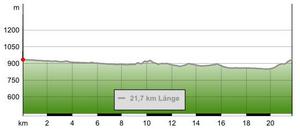 As I knew this stage was going to be mainly flat, I wore my trail shoes instead of boots.
It was going to be another hot, sunny day, so I intended to travel light.
I rejoined the Lechweg at Stanzach and carried on along the trail, which followed the side of the river bank towards Forchach.
It was very easy walking, just a straight, flat, cycle path with the river to my left and woods to my right.
I sensed also that I was now truly in the foothills of the Alps, as the mountains were becoming smaller and fewer.
This stretch of the Lech seemed to be in a flood plain area.
The distance between the banks was much wider with vast shoals of gravel, topped with dead trees and other debris.
The river had split into a few separate streams, finding paths through the gravel banks.
This area is of great interest to bird watchers.
However, having a tight schedule doesn't allow much time to linger.
It is a real pity the Lechweg does not attain any height in this section as the view would be more interesting.
A good view is possible from Baichlstein, a detour near Stanzach and unfortunately not part of the Lechweg and the "Sporting Variant" doesn't allow sufficient time to include this detour.
The trail from Stanzach carried on, passing Forchach, until reaching a "Lechweg Signature Feature", a wooden passenger suspension bridge.
The wooden bridge was constructed in 1906 and certainly looks it's age. I did venture on the bridge, which swayed more than the one at Holzgau, despite being much shorter at 75 metres.
This bridge features in all the Lechweg marketing publications, showing happy hikers crossing it, however the trail does not actually cross it.
After this brief diversion from the serious business of tramping along a nondescript section of the trail, I carried on until reaching the Johannesbrücke, a modern road bridge outside the village of Weissenbach.
As I knew this stage was going to be mainly flat, I wore my trail shoes instead of boots.
It was going to be another hot, sunny day, so I intended to travel light.
I rejoined the Lechweg at Stanzach and carried on along the trail, which followed the side of the river bank towards Forchach.
It was very easy walking, just a straight, flat, cycle path with the river to my left and woods to my right.
I sensed also that I was now truly in the foothills of the Alps, as the mountains were becoming smaller and fewer.
This stretch of the Lech seemed to be in a flood plain area.
The distance between the banks was much wider with vast shoals of gravel, topped with dead trees and other debris.
The river had split into a few separate streams, finding paths through the gravel banks.
This area is of great interest to bird watchers.
However, having a tight schedule doesn't allow much time to linger.
It is a real pity the Lechweg does not attain any height in this section as the view would be more interesting.
A good view is possible from Baichlstein, a detour near Stanzach and unfortunately not part of the Lechweg and the "Sporting Variant" doesn't allow sufficient time to include this detour.
The trail from Stanzach carried on, passing Forchach, until reaching a "Lechweg Signature Feature", a wooden passenger suspension bridge.
The wooden bridge was constructed in 1906 and certainly looks it's age. I did venture on the bridge, which swayed more than the one at Holzgau, despite being much shorter at 75 metres.
This bridge features in all the Lechweg marketing publications, showing happy hikers crossing it, however the trail does not actually cross it.
After this brief diversion from the serious business of tramping along a nondescript section of the trail, I carried on until reaching the Johannesbrücke, a modern road bridge outside the village of Weissenbach.
I was getting quite bored by now, having tramped along a flat path for about 5 miles, but was unprepared for the stupidity of the next section.
The trail now followed a convoluted and pointless route to get to Weissenbach.
It wound aimlessly around cycle tracks, through gravel quarries, past a nice leisure lake, along the main road then into a maze of tarmac roads around farm meadows.
I lost my patience at the farm fields.
In the distance, I could see the spire of the St. Sebastian parish church and made my own way to get there.
Weissenbach is a delightful little village and I don't understand why the Lechweg tries so hard to avoid getting to it.
After lunch at a friendly small restaurant in Weissenbach, I crossed over the Lech, passed the outlet of the Rotlechschlucht and headed towards towards Rieden.
I was happy to be walking uphill at last.
Most of the walk was through meadows and I had to stay aware of the seemingly homicidal farmers whizzing furiously around on their tractors.
They were all hay making and I was fascinated watching them using the tractor attachments that automatically makes the grass into large cartwheels and encapsulates them in plastic.
Rieden is a tiny hamlet, almost completely hidden from the outside world.
The Lechweg follows the tarmac road downhill from Rieden where there were climbers teaching children to rock climb on the near vertical cliff faces along the road.
This was a pleasant walk, but unfortunately it all ended when I reached the main Reutte-Lech road.
After crossing the main road, the most boring part of the Lechweg began.
I was now on a long, straight hard gravel path heading towards Reutte.
The Lech was on my left and to my right was a wasteland of gravel.
I plodded along in the hot afternoon for what seemed like an eternity.
Sometimes, the fields of gravel were replaced by trees.
From across the river, I could hear the heavy traffic on the main road and also see the rooftops of buildings.
However, to be fair, I did look at the map and there seems to be no other alternatives to this section of the trail.
I experienced a feeling of delight when I eventually saw the bridge at Höfen ahead of me, knowing I was coming to the end of this dreadful stretch.
With relief, I crossed the bridge, passed a few houses and an airfield and arrived at the main road next to a bus stop. A bus to Holzgau was due almost immediately, but I wanted to end the day on a positive note, so chose to carry on to Wängle.
The Lechweg took me up a tarmac, tree-shaded road which was parallel to a dried-up riverbed.
At the end of the tarmac road, I walked up further along the side of meadows to Winkl at the foot of the Hahnenkamm Mountain.
When I reached the top of the meadow and found a well located bench with a nice view, I decided this was the end of the day's walk.
I sat on the bench and enjoyed the impressive vista in the afternoon sun, looking over Wängle with it's prominent church, Reutte behind and mountains in the distance.
The church at Wängle looked even more impressive close-up, when I arrived in the village.
Unfortunately, I seemed to have missed the local buses, so walked down to Reutte's Altstadt for a well deserved couple of beers before catching the bus back to Holzgau.
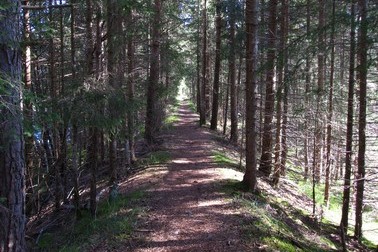
A nice start to the trail from Stanzach
|
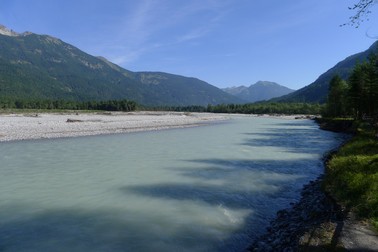
Following the Lech from Stanzach
|
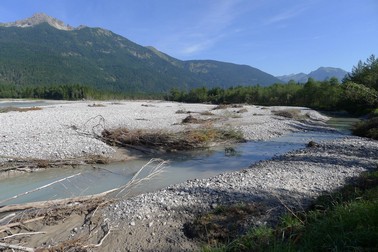
First view of the banks of gravel near Stanzach
|
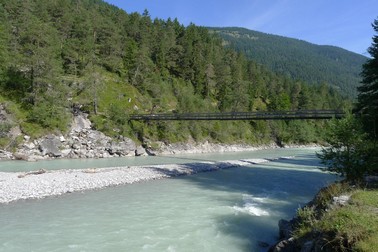
Approaching the hanging bridge at Forchach
|
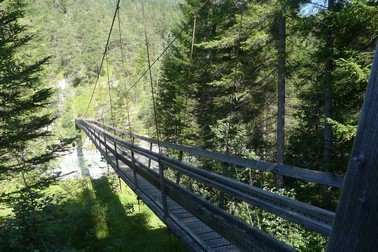
The Forchach hanging bridge, built in 1906
|
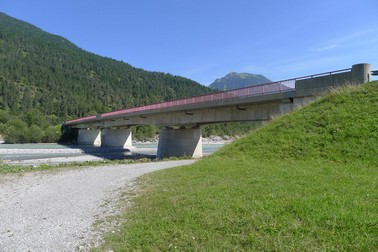
The Johannesbrücke
|
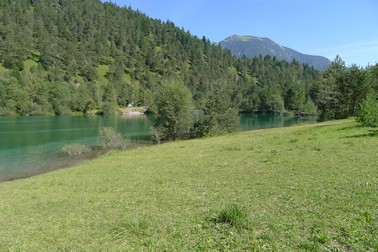
Leisure lake near Weissenbach
|
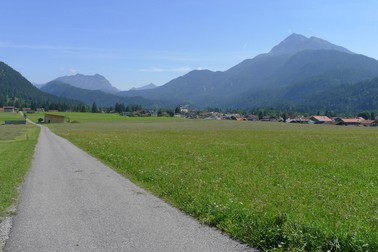
Across the meadows to Weissenbach
|
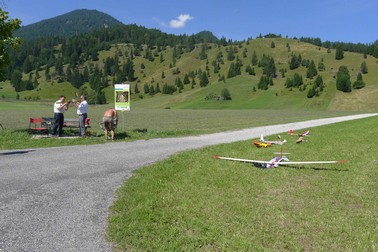
Powered flight enthusiasts in the meadows
|
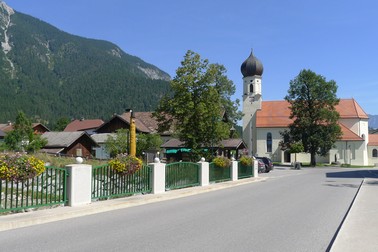
St. Sebastian parish church at Weissenbach
|
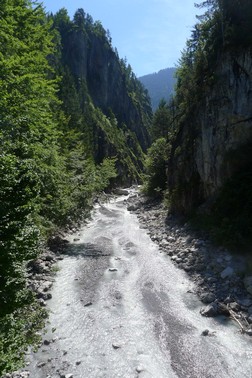
View up the Rotlechschlucht
|
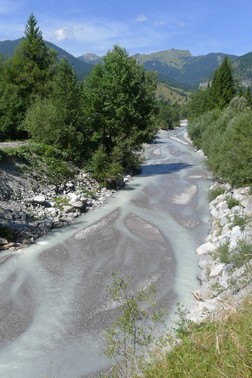
The Rotlechbach joining the Lech
|
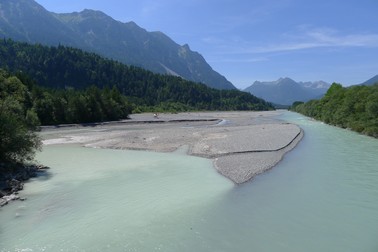
View of the Lech from the bridge at Weissenbach
|
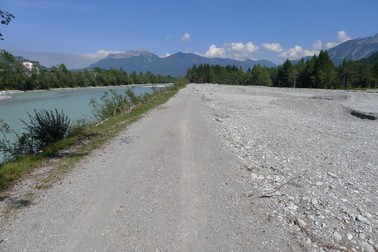
The long drag from Rieden towards Höfen
|
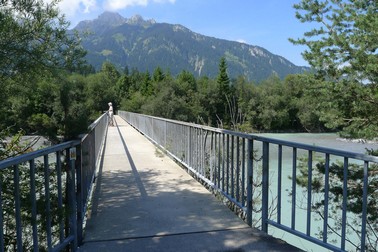
The bridge at Höfen
|
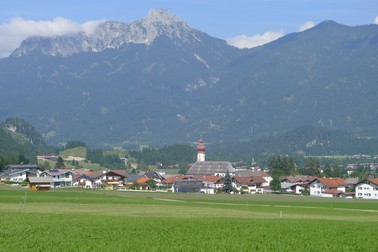
Nice view from Winkl across to Wängle
|
[Home]
 As I knew this stage was going to be mainly flat, I wore my trail shoes instead of boots.
It was going to be another hot, sunny day, so I intended to travel light.
I rejoined the Lechweg at Stanzach and carried on along the trail, which followed the side of the river bank towards Forchach.
It was very easy walking, just a straight, flat, cycle path with the river to my left and woods to my right.
I sensed also that I was now truly in the foothills of the Alps, as the mountains were becoming smaller and fewer.
This stretch of the Lech seemed to be in a flood plain area.
The distance between the banks was much wider with vast shoals of gravel, topped with dead trees and other debris.
The river had split into a few separate streams, finding paths through the gravel banks.
This area is of great interest to bird watchers.
However, having a tight schedule doesn't allow much time to linger.
It is a real pity the Lechweg does not attain any height in this section as the view would be more interesting.
A good view is possible from Baichlstein, a detour near Stanzach and unfortunately not part of the Lechweg and the "Sporting Variant" doesn't allow sufficient time to include this detour.
The trail from Stanzach carried on, passing Forchach, until reaching a "Lechweg Signature Feature", a wooden passenger suspension bridge.
The wooden bridge was constructed in 1906 and certainly looks it's age. I did venture on the bridge, which swayed more than the one at Holzgau, despite being much shorter at 75 metres.
This bridge features in all the Lechweg marketing publications, showing happy hikers crossing it, however the trail does not actually cross it.
After this brief diversion from the serious business of tramping along a nondescript section of the trail, I carried on until reaching the Johannesbrücke, a modern road bridge outside the village of Weissenbach.
As I knew this stage was going to be mainly flat, I wore my trail shoes instead of boots.
It was going to be another hot, sunny day, so I intended to travel light.
I rejoined the Lechweg at Stanzach and carried on along the trail, which followed the side of the river bank towards Forchach.
It was very easy walking, just a straight, flat, cycle path with the river to my left and woods to my right.
I sensed also that I was now truly in the foothills of the Alps, as the mountains were becoming smaller and fewer.
This stretch of the Lech seemed to be in a flood plain area.
The distance between the banks was much wider with vast shoals of gravel, topped with dead trees and other debris.
The river had split into a few separate streams, finding paths through the gravel banks.
This area is of great interest to bird watchers.
However, having a tight schedule doesn't allow much time to linger.
It is a real pity the Lechweg does not attain any height in this section as the view would be more interesting.
A good view is possible from Baichlstein, a detour near Stanzach and unfortunately not part of the Lechweg and the "Sporting Variant" doesn't allow sufficient time to include this detour.
The trail from Stanzach carried on, passing Forchach, until reaching a "Lechweg Signature Feature", a wooden passenger suspension bridge.
The wooden bridge was constructed in 1906 and certainly looks it's age. I did venture on the bridge, which swayed more than the one at Holzgau, despite being much shorter at 75 metres.
This bridge features in all the Lechweg marketing publications, showing happy hikers crossing it, however the trail does not actually cross it.
After this brief diversion from the serious business of tramping along a nondescript section of the trail, I carried on until reaching the Johannesbrücke, a modern road bridge outside the village of Weissenbach.














